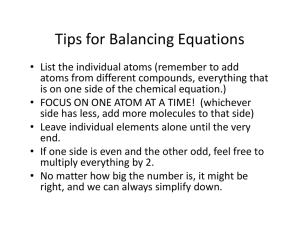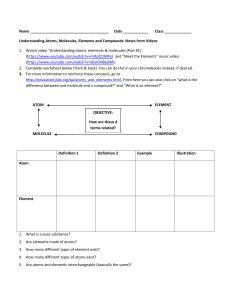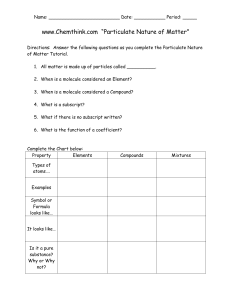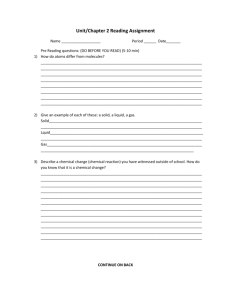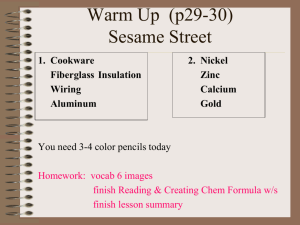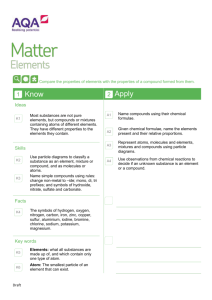Section 1 PowerPoint
advertisement
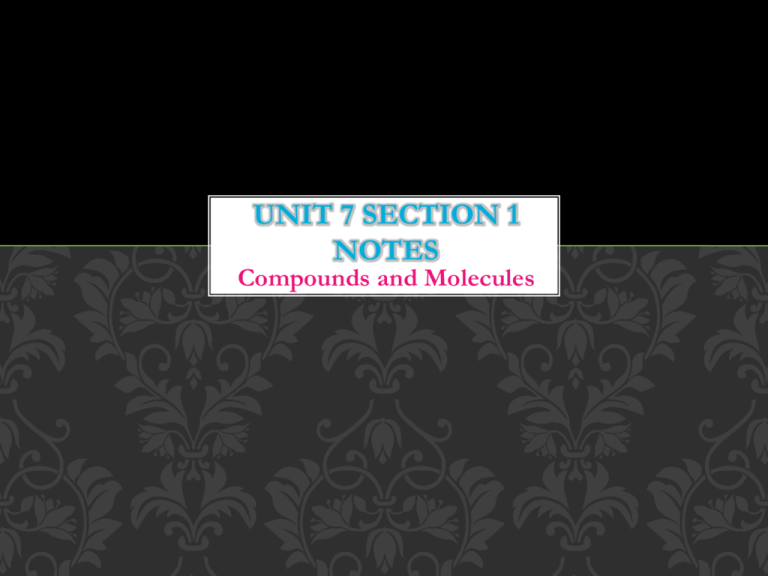
UNIT 7 SECTION 1 NOTES Compounds and Molecules ELEMENTS: A REVIEW • Made of individual atoms. • Cannot be broken down into simpler substances. • Listed on the periodic table. • The building blocks of all matter. MIXTURES: A REVIEW • Different substances just placed together • Substances keep their individual properties • Example: Mixing yellow and blue paint to make green paint: color has changed but not the properties • Can be separated (Example: sand and water) + → COMPOUNDS • Compound: 2 or more elements chemically joined together in definite ratios • The characteristics of each element are lost when a compound is formed • Think of Table salt: Sodium, a metal, combines with chlorine, a gas, to make table salt, a small white crystal. + → MOLECULES • Molecules are the smallest units of a compound that retains the characteristics of the compound. This is one molecule of caffeine: COMPOUND CHARACTERISTICS • Formed through CHEMICAL BONDING • Compounds have a chemical formula • Compounds are not easily separated • New properties: different than the elements that it is made from CHEMICAL FORMULAS • A compound ALWAYS has the same chemical formula. • A chemical formula shows the types and numbers of atoms or ions making up the simplest unit of the compound. EXAMPLES OF CHEMICAL FORMULAS • Note: When there is no subscript, it is understood to be “1”. • The larger number in front is called a coefficient • H2O: Water: 2 Hydrogen atoms; 1 Oxygen atom • C12H22O11: Sugar: 12 Carbon atoms; 22 Hydrogen atoms; 11 Oxygen atoms • NaCl: Table Salt: 1 Sodium atom; 1 Chlorine atom EXAMPLES OF CHEMICAL FORMULAS Use the chemical formula to list each element by symbol and tell how many atoms there are in the compound. • • • • • • • • CO2 2H2O Mg(OH)2 3NaHCO3 2H2SO4 2CaCO3 3C6H8O7 4Be(OH)2 EXAMPLES OF CHEMICAL FORMULAS Use the chemical formula to list each element by symbol and tell how many atoms there are in the compound. • • • • • • • • CO2 2H2O Mg(OH)2 3NaHCO3 2H2SO4 2CaCO3 3C6H8O7 4Be(OH)2 C= H= Mg = Na = H= Ca = C= Be = O= O= O= H= H= C= S= O= C= O= H= O= O= H= O= EXAMPLES OF CHEMICAL FORMULAS Use the chemical formula to list each element by symbol and tell how many atoms there are in the compound. • • • • • • • • CO2 2H2O Mg(OH)2 3NaHCO3 2H2SO4 2CaCO3 3C6H8O7 4Be(OH)2 C=1 O=2 H=4 O=4 Mg = 1 O = 2 Na = 3 H = 3 H=4 S=2 Ca = 2 C = 2 C = 18 H = 24 Be = 4 O = 8 H=2 C=3 O=8 O=6 O = 21 H=8 O=9 LAW OF DEFINITE PROPORTIONS • Law of Definite Proportions: Compounds are ALWAYS made of the same elements in the same proportion by mass. CHEMICAL STRUCTURE • Chemical Structure is the way the compound’s atoms are bonded to make the compound. • Just as the structure of buildings can be represented by blueprints, the structure of chemical compounds can be shown by various models. Different models show different aspects of compounds. MODELS OF COMPOUNDS • Ball and Stick Model • Space Filling Model • Structural Formula PROPERTIES OF COMPOUNDS What determines many of a compound’s properties? • The atoms present in a compound • The way the atoms are arranged (chemical structure) This shows how a crystal lattice is formed from sodium and chlorine atoms to form table salt. STRUCTURE AND PROPERTIES • Network Crystals: typically based on nonmetals like carbon, silicon, and boron • Held together by COVALENT bonds • VERY strong network or lattice • VERY high melting point and great physical strength; takes a lot of energy to weaken the bonds. • Poor conductors of electricity • Often very hard and strong; typically will not dissolve in water. STRUCTURE AND PROPERTIES • Examples of network crystals: • Quartz: made of silicon dioxide, SiO2 Every Si atom is bonded to 4 oxygen atoms; all bond angles are the same at 109.5˚, which holds the atoms together in a strong, rigid structure • Diamond STRUCTURE AND PROPERTIES • Molecular Crystals: Some compounds are made of molecules • Compounds made of molecules DO NOT have a strong attraction holding atoms together, so they have a lower melting and boiling point than compounds with ionic bonds. • Example: A molecule of sugar is made between bonds of carbon, hydrogen, and oxygen and the attraction between the molecules is much weaker than an ionic bond. STRUCTURE AND PROPERTIES • Ionic Crystals: Some networks are made of bonded ions, which have very strong attractions between the positively and negatively charged ions • The strong attraction requires a lot of energy to break the bonds, which is why these network structures have high melting and boiling points. • Examples: table salt, NaCl; magnesium oxide, MgO STRENGTH OF ATTRACTION BETWEEN MOLECULES • The weaker the force of attraction between molecules, the easier the substance will be to break apart • Molecules of gases have weak attractions to one another, so they spread out and take up a lot of space. DIATOMIC MOLECULES • Diatomic Molecule: 2 atoms of the same element that have covalently bonded together. • 7 Diatomic molecules: Oxygen, Iodine, Hydrogen, Nitrogen, Chlorine, Fluorine, and Bromine • Pneumonic device: Oh, I Have Nice Closets For Brooms
